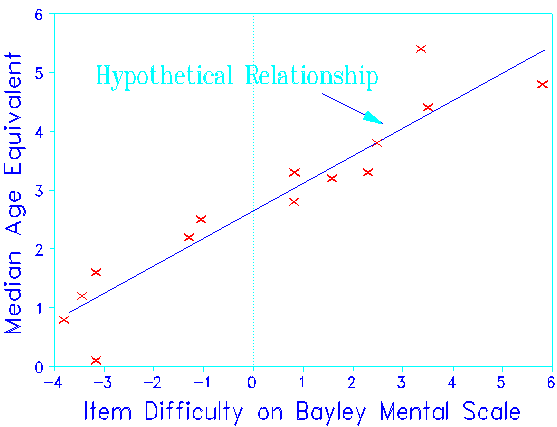

The greatest challenge to practitioners of Rasch measurement is not test construction or analysis, but communication. The most clear-cut and insightful findings are valueless if the intended audience are baffled or, worse, antagonized by the method used to obtain them. Let us review four Rasch measurement introductions with a view to enhancing our own endeavors to explain Rasch measurement.

|

|
The shortest at 9 pages is Snyder & Sheehan (1992). They include no mathematical formulae, but take a page to recite the operation and specifications (incorrectly termed "assumptions") of the model. They describe three functions of Rasch analysis: item banking (with a useful table of benefits), test analysis and person measurement. Three tables of measures are included that beg to be plotted - see the "Bayley Mental Scale" Figure for a plot of their Table 2 with a "best fit" line added. In discussing person measurement they emphasize that a focussed subset of items is as informative as an entire test, but speedier and less of a burden. This introduction is sketchy, but is informative for a beginner.
Next in length at 12 pages, and a little more mathematical, is Hawkins (1987). She commences with an explanation of latent trait models and a plot of ICCs. The Rasch model is introduced as merely a "one-parameter" simplification. Her example concerns two versions of the same 75 item MCQ test. The two calibrations for each item are tabulated and discovered to have a correlation of .91. Does this summary statistic confirm Rasch objectivity? A plot with confidence bands would have told all - see Figure showing Hawkins' data. Finally, she discusses how to use test information curves to aid test construction. This introduction will mislead, rather than assist, a neophyte.
Longer at 18 pages and more complex De Ayala (1993). This is a mathematically sophisticated introduction to ordered and nominal logit-linear response models, including models algebraically similar to, but conceptually far from, Rasch models. De Ayala expects the reader to follow a sequence of algebraic manipulations, and also to understand matrix notation. This introduction is for psychometricians only.
Longest at 40 pages, oldest and in German, but included as a contrast, is Stene (1968). This introduction is close to Rasch (1960/1980) in content, algebra and style. It is a convenient summary of Rasch's algebra. Stene also presents a "practical example" that demonstrates pair-wise estimation of item calibrations, along with a graphical investigation of fit. Rasch measurement, a theory often shrouded in algebraic confusion, is revealed by Stene to be a useful and practical tool for any test constructor with a pocket calculator and a sheet of graph paper. Writers of Rasch introductions would do well to build on pages 255-263 of Stene's chapter.
John M. Linacre
De Ayala R J 1993. Methods, plainly speaking - an introduction to polytomous item response theory models. Measurement and Evaluation in Counseling and Development. 25(4) 172-189.
Hawkins K W 1987. Use of the Rasch model in Communication Education: an explanation and example application. Communication Education 36(2) 107-118.
Snyder S & Sheehan R 1992. Research methods - the Rasch measurement model: an introduction. Journal of Early Intervention 166(1) 87-95.
Stene J 1968. Introduction to the Rasch theory of psychological measurement (in German). Chapter 9, 229-268, in G.H. Fischer (Ed.) Psychologische Testtheorie. Bern: Hans Huber.
Four introductions to the Rasch model. Linacre JM. … 1993, 7:2 p.290-1
Four introductions to the Rasch model. Linacre JM. … Rasch Measurement Transactions, 1993, 1993, 7:2 p.290-1
| Forum | Rasch Measurement Forum to discuss any Rasch-related topic |
Go to Top of Page
Go to index of all Rasch Measurement Transactions
AERA members: Join the Rasch Measurement SIG and receive the printed version of RMT
Some back issues of RMT are available as bound volumes
Subscribe to Journal of Applied Measurement
Go to Institute for Objective Measurement Home Page. The Rasch Measurement SIG (AERA) thanks the Institute for Objective Measurement for inviting the publication of Rasch Measurement Transactions on the Institute's website, www.rasch.org.
| Coming Rasch-related Events | |
|---|---|
| Jan. 16 - Feb. 13, 2025, Fri.-Fri. | On-line workshop: Rasch Measurement - Core Topics (E. Smith, Winsteps), www.statistics.com |
| Apr. 8 - Apr. 11, 2026, Wed.-Sat. | National Council for Measurement in Education - Los Angeles, CA, ncme.org/events/2026-annual-meeting |
| Apr. 8 - Apr. 12, 2026, Wed.-Sun. | American Educational Research Association - Los Angeles, CA, www.aera.net/AERA2026 |
| May. 15 - June 12, 2026, Fri.-Fri. | On-line workshop: Rasch Measurement - Core Topics (E. Smith, Winsteps), www.statistics.com |
| June 19 - July 25, 2026, Fri.-Sat. | On-line workshop: Rasch Measurement - Further Topics (E. Smith, Winsteps), www.statistics.com |
The URL of this page is www.rasch.org/rmt/rmt72g.htm
Website: www.rasch.org/rmt/contents.htm